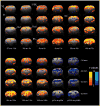Focal BOLD fMRI changes in bicuculline-induced tonic-clonic seizures in the rat
- PMID: 20079442
- PMCID: PMC2830359
- DOI: 10.1016/j.neuroimage.2010.01.006
Focal BOLD fMRI changes in bicuculline-induced tonic-clonic seizures in the rat
Abstract
Generalized tonic-clonic seizures cause widespread physiological changes throughout the cerebral cortex and subcortical structures in the brain. Using combined blood oxygen level dependent (BOLD) functional magnetic resonance imaging (fMRI) at 9.4 T and electroencephalography (EEG), these changes can be characterized with high spatiotemporal resolution. We studied BOLD changes in anesthetized Wistar rats during bicuculline-induced tonic-clonic seizures. Bicuculline, a GABA(A) receptor antagonist, was injected systemically and seizure activity was observed on EEG as high-amplitude, high-frequency polyspike discharges followed by clonic paroxysmal activity of lower frequency, with mean electrographic seizure duration of 349 s. Our aim was to characterize the spatial localization, direction, and timing of BOLD signal changes during the pre-ictal, ictal and post-ictal periods. Group analysis was performed across seizures using paired t-maps of BOLD signal superimposed on high-resolution anatomical images. Regional analysis was then performed using volumes of interest to quantify BOLD timecourses. In the pre-ictal period we found focal BOLD increases in specific areas of somatosensory cortex (S1, S2) and thalamus several seconds before seizure onset. During seizures we observed BOLD increases in cortex, brainstem and thalamus and BOLD decreases in the hippocampus. The largest ictal BOLD increases remained in the focal regions of somatosensory cortex showing pre-ictal increases. During the post-ictal period we observed widespread BOLD decreases. These findings support a model in which "generalized" tonic-clonic seizures begin with focal changes before electrographic seizure onset, which progress to non-uniform changes during seizures, possibly shedding light on the etiology and pathophysiology of similar seizures in humans.
Copyright 2010 Elsevier Inc. All rights reserved.
Figures




References
-
- Ackermann RF, Engel J, Jr, Baxter L. Positron emission tomography and autoradiographic studies of glucose utilization following electroconvulsive seizures in humans and rats. Annals of the New York Academy of Sciences. 1986;462:263–269. - PubMed
-
- Andre V, Henry D, Nehlig A. Dynamic variations of local cerebral blood flow in maximal electroshock seizures in the rat. Epilepsia. 2002;43:1120–1128. - PubMed
-
- Benner T, van der Kouwe AJ, Kirsch JE, Sorensen AG. Real-time RF pulse adjustment for B0 drift correction. Magn Reson Med. 2006;56:204–209. - PubMed
-
- Blumenfeld H, McNally KA, Ostroff RB, Zubal IG. Targeted prefrontal cortical activation with bifrontal ECT. Psychiatry Res. 2003a;123:165–170. - PubMed
Publication types
MeSH terms
Substances
Grants and funding
LinkOut - more resources
Full Text Sources
Other Literature Sources
Medical

